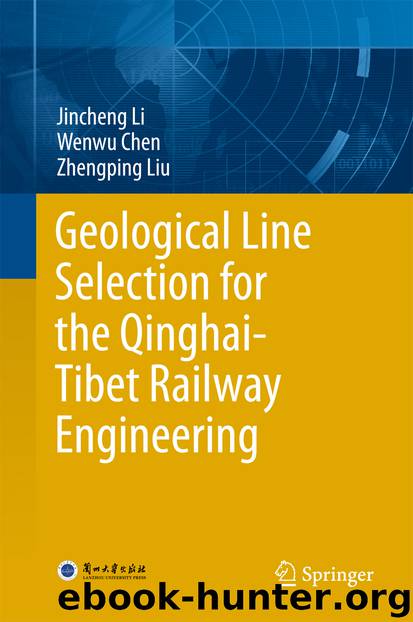Geological Line Selection for the Qinghai-Tibet Railway Engineering by Jincheng Li Wenwu Chen & Zhengping Liu

Author:Jincheng Li, Wenwu Chen & Zhengping Liu
Language: eng
Format: epub
Publisher: Springer Berlin Heidelberg, Berlin, Heidelberg
4.2.5 Other Seismic Tectonic Belts
The overall seismic tectonic belt of Hoh Xil runs NWW, controlled by the active faults of Hoh Xil. The main controlling earthquake of Hoh Xil seismic tectonic belt includes the active faults of Chumar River, Wudaoliang, northern Hoh Xil Mountains, and southern Hoh Xil Mountains. The seismic tectonic belt of Donggu–Luhuo–Kangding segment has obvious strong Xianshui River seismic belt. Strong earthquakes of Ms7.0–7.5 along the active faults of southern Hoh Xil Mountains in the Holocene, forming earthquake scarps of length >20 km and height 1.5 m. The scarps cross the Qinghai–Tibet Railway, and they cut modern turfs and sand layers of the Holocene, left-laterally dislocating modern gullies of 4–4.5 m (Fig. 4.14) along ancient earthquake ruptures west of the Qinghai–Tibet Railway. The development of earthquake ruptures and the pull-apart basins in the earthquake scarp of 5–10 m, the occurrence of the Holocene sandy tectonic wedge of earthquake ruptures in tension–torsional in the NE direction, in addition to the formation of perennial frost heave hugelboden in the axial direction of NE after the earthquake show that the strike-slip faults of Hoh Xil in the Holocene have strong tectonic activities.
Fig. 4.14Ancient earthquake ruins of seismic tectonic zones of Hoh Xil
Download
This site does not store any files on its server. We only index and link to content provided by other sites. Please contact the content providers to delete copyright contents if any and email us, we'll remove relevant links or contents immediately.
| Automotive | Engineering |
| Transportation |
Whiskies Galore by Ian Buxton(41541)
Introduction to Aircraft Design (Cambridge Aerospace Series) by John P. Fielding(32893)
Small Unmanned Fixed-wing Aircraft Design by Andrew J. Keane Andras Sobester James P. Scanlan & András Sóbester & James P. Scanlan(32580)
Craft Beer for the Homebrewer by Michael Agnew(17938)
Turbulence by E. J. Noyes(7717)
The Complete Stick Figure Physics Tutorials by Allen Sarah(7150)
Kaplan MCAT General Chemistry Review by Kaplan(6606)
The Thirst by Nesbo Jo(6450)
Bad Blood by John Carreyrou(6286)
Modelling of Convective Heat and Mass Transfer in Rotating Flows by Igor V. Shevchuk(6231)
Learning SQL by Alan Beaulieu(6043)
Weapons of Math Destruction by Cathy O'Neil(5853)
Man-made Catastrophes and Risk Information Concealment by Dmitry Chernov & Didier Sornette(5672)
Digital Minimalism by Cal Newport;(5397)
Life 3.0: Being Human in the Age of Artificial Intelligence by Tegmark Max(5198)
iGen by Jean M. Twenge(5168)
Secrets of Antigravity Propulsion: Tesla, UFOs, and Classified Aerospace Technology by Ph.D. Paul A. Laviolette(5005)
Design of Trajectory Optimization Approach for Space Maneuver Vehicle Skip Entry Problems by Runqi Chai & Al Savvaris & Antonios Tsourdos & Senchun Chai(4849)
Electronic Devices & Circuits by Jacob Millman & Christos C. Halkias(4756)
